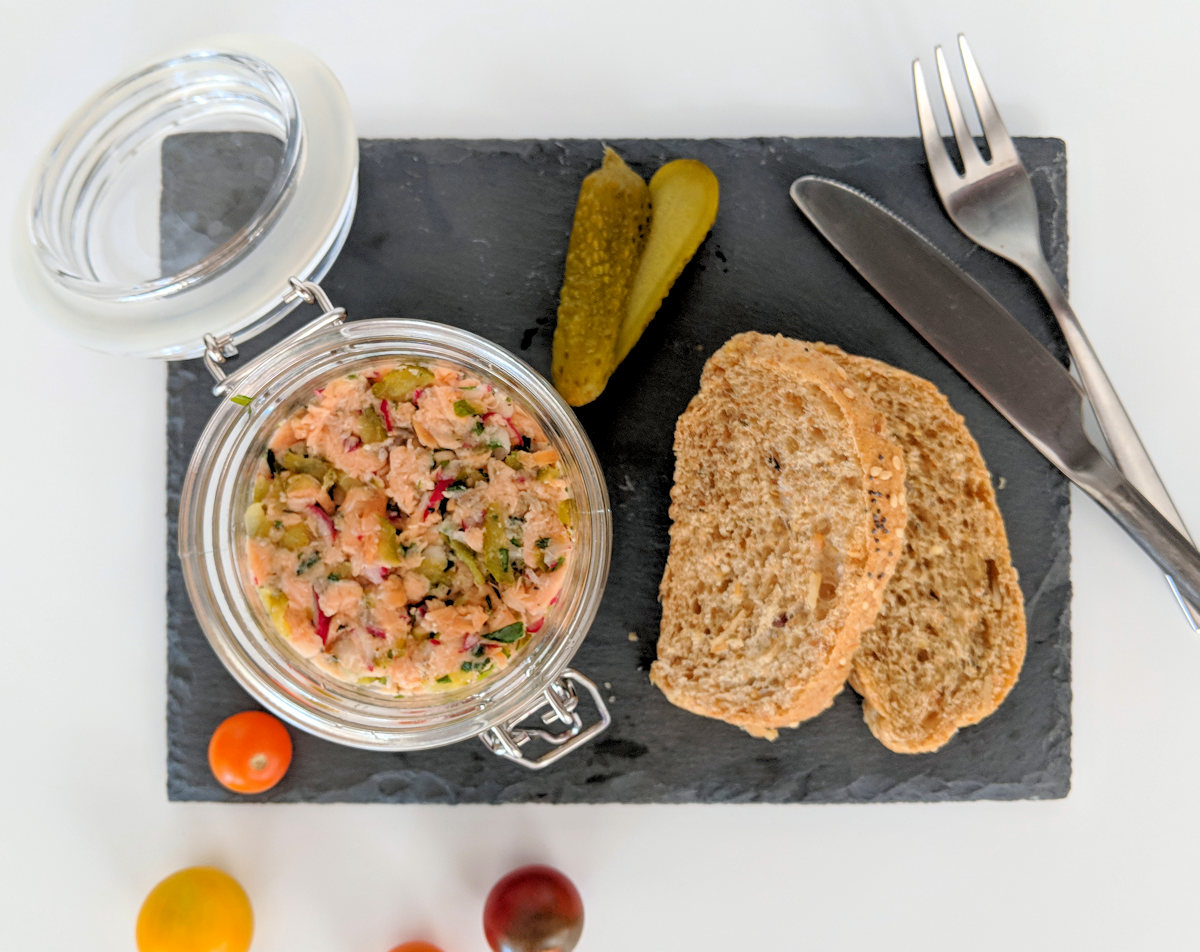Smooth pâté made with salmon fillets roasted in low oven, which makes them buttery and succulent. With a crunch from radish and gherkin, and a fresh tarragon flavour.

My Grandma’s pâté
If my grandmother could see what I call ‘pâté’ she’d disown me. ‘Pâté’ in her interpretation was a very specific, elaborate affair, duly pronounced with a capital ‘P’. It rode out onto the Christmas table, took the royal seat at Easter or whenever the occasion was important enough to be honoured with a pasztet (pâté).
Pâté was baked, never steamed. Pâté was made from very specific cuts of meat: pork, pork and pork, you’d never guess she had Jewish ancestry. If I remember clearly, there was bacon involved, copious quantities of liver, about a bucket of butter and several dozens of eggs. It was no mean affair.
She’d make a few large loaf tins of it at any one time as the memory of the flavour had to last the diners for at least six months to come. None of that vulgar, peasant nonsense of smearing pâté on bread like it was common Liverwurst. Pasztet was sturdy enough to be sliced, plated and treated with respect and a dollop of mustard. I wish I’d kept her recipe because, jests aside, it was a glorious specimen of charcuterie.
She’d scoff (if scoffing wasn’t unladylike) at the ideas of fish pâté, mushroom terrine or vegan rillettes. She wouldn’t think my salmon concoction was worth a second glance.
But hey! There’s only so much pork you can eat, plus who would have the time to roast and grind and mince and mix and bake all that meat? And, as Grandma also used to say, if you don’t get what you like, you have to like what you get.
Cooking at 100C? That’s barely warm!
Low temperature cooking is my favourite method. Not for everything to be sure, but some meats and fish that you should not overcook will come out wonderfully juicy after a longish spell in a barely warm oven.
Following that, things like steaks or roasting joints will only need a blast of heat from a frying pan or grill, to complete the work with that drool inducing Maillard reaction result: caramelised protein.
It gives you the results very close to sous-vide cooking without the expensive gear and specialist knowledge.
Salmon cooked at low temperature
Salmon suits low temperature cooking perfectly. How often have you removed a fillet from the oven or grill only to find it dry and stringy?
Some people, me included, like it still slightly translucent in the middle but for other palates it should be caught at that elusive moment between fully opaque and dried out.
Low temperature is gentle, obviously, so it doesn’t violently shrink tissues and expel all moisture from them. Salmon cooked at 100C is delicious: succulent and plump, tender and juicy. Just like the poached salmon sides at posh buffets which I strongly suspect are cooked sous-vide rather than poached.
Mash it up now
And the pâté couldn’t be easier to make: just mash up the tender, juicy salmon with a fork and fold in some finely chopped tarragon leaves, gherkins and radish.
The beauty of cooking salmon like that for a pâté is that there is absolutely no need to add mayonnaise as it will render itself to a smooth paste easily. Healthy – and so delicious!
Variations
Instead of tarragon, add some fresh chopped dill and a spoonful of cream cheese.
Skip gherkin and radish and go for pickled jalapenos instead, for some gentle heat.
Cook a bacon rasher till crisp and crumble it into mashed up salmon, with a drizzle of maple juice.
More salmon recipes
Homemade gravadlax, salmon cured in the fridge with salt and sugar, flavoured with fennel, caraway and lemon zest. Three minutes of work, four days wait and you have an astonishing party starter or a sandwich filling.
Slow roasted salmon with dill sauce, baked at 200F / 100C. Salmon roasted in very low oven, at 100C, takes about 45 minutes to cook. Slow roasted salmon is moist and succulent, better than poached, and here served with the easiest dill sauce that goes with any fish.
Steamed side of salmon in a foil parcel with dill, chilies and soy sauce. Steaming takes only 15 minutes and the salmon can be served hot or cold.
More sandwich filler recipes
Crab butter with Thai chilli flavour, fantastic on toast or fresh bread. Chili crab butter is easy to make and can be served as a dip or a sandwich spread.
Porchetta, classic Italian pork roast, prepared with the easiest cut to handle: pork collar, also sold as neck or shoulder. Served usually cold in bread rolls, it is also gorgeous as a dinner roast.
Greek pork gyros served with tzatziki and pita bread. Another street dish impossible to replicate at home? Wrong: you can cook it in the oven.